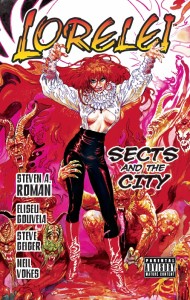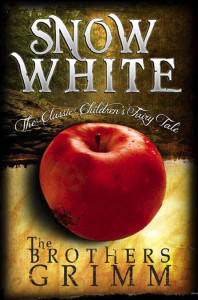Yesterday, I told you about a 2015 interview that I did with Steve Williams of the site Write a Revolution…which, I recently discovered, has disappeared from the ’Net—along with WaR’s website. So, for those of you who might have missed it the first time, I’m serializing that interview here at Zwieback Central for your reading pleasure. Part 1 was posted yesterday. Now here’s Part 2…
WaR: Tell us a bit more about StarWarp Concepts—what services you provide, and where it differs from the many other publishing companies that have been around since the Indie Pub boom.
SR: Well, like I said [in Part 1] we originally started out publishing the Lorelei comic, but since 2010 we’ve expanded into graphic novels and straight books—young adult novels, illustrated classic reprints, an artist sketchbook, and an upcoming writing guide for fantasy authors. Occasionally we still do comics—we published a tie-in to the young adult novel series, The Saga of Pandora Zwieback, and [in 2015] we released the horror anthology Lorelei Presents: House Macabre. I guess that would mean we’re somewhat in a gray area between being a book publisher and a comic publisher, which probably makes us different from most indie houses. I’m okay with that—it gives us two types of audiences to appeal to.
 WaR: What level or research and planning goes into each project you undertake at StarWarp?
WaR: What level or research and planning goes into each project you undertake at StarWarp?
SR: I’m not really the kind who does market research to see if there’s an audience for what we publish, because more often than not our titles tend to be counter to whatever is considered hot or trendy at any given time. When the first Pan novel, Blood Feud, came out, Twilight was still popular—but there’s nothing romantic or “sparkly” about the vampires I write; in fact, some reviewers went out of their way to point out how much Blood Feud is a polar opposite to Meyer’s books, in terms of depth of characterization and the violent nature of the vampires.
The Lorelei projects are completely at odds with today’s comic market, given the sexual nature of the character and her appearance—the blown-out hair, the unbuttoned blouse, and the stiletto-heel boots. But then again, I’m not going after people who only read mainstream or alt-press comics. Like I said [in Part 1], Lori is a throwback to old horror comics—if you’re not into those, then Lorelei probably won’t appeal to you. And yet the Sects and the City graphic novel is our most popular title overall, especially with horror fans.
 The Illustrated Classics line we have—which right now consists of the vampire novella Carmilla, Edgar Rice Burroughs’ A Princess of Mars, and the Brothers Grimm’s Snow White—are chosen for various reasons: they’re well-written books I enjoy; there’s some movie or event I can tie them to; or I know they’ll appeal to dark fantasy fans. Carmilla involves vampires, so that was a no-brainer—vampires will never go out of style. A Princess of Mars was published to take advantage of Disney’s John Carter movie, since the movie’s based on that novel. Snow White came about because I found a children’s storybook published in the late 1800s, with pristine, full-color illustrations; since the book was in the public domain, we scanned the art and released it as an e-book. And the original spot illustrations for Carmilla and Princess—all done by Eliseu Gouveia—are a major selling point for those books, especially at conventions.
The Illustrated Classics line we have—which right now consists of the vampire novella Carmilla, Edgar Rice Burroughs’ A Princess of Mars, and the Brothers Grimm’s Snow White—are chosen for various reasons: they’re well-written books I enjoy; there’s some movie or event I can tie them to; or I know they’ll appeal to dark fantasy fans. Carmilla involves vampires, so that was a no-brainer—vampires will never go out of style. A Princess of Mars was published to take advantage of Disney’s John Carter movie, since the movie’s based on that novel. Snow White came about because I found a children’s storybook published in the late 1800s, with pristine, full-color illustrations; since the book was in the public domain, we scanned the art and released it as an e-book. And the original spot illustrations for Carmilla and Princess—all done by Eliseu Gouveia—are a major selling point for those books, especially at conventions.
WaR: Let’s talk about book publicity and book marketing ideas. Which social media sites are you registered with and post on? Which do you find most effective for engagement?
SR: I have Facebook pages for StarWarp Concepts and the Saga of Pandora Zwieback book series, and author pages at Amazon.com and Goodreads. I also review comics for a site called Comics for Sinners, whose owner links back to the StarWarp site. I’m not a Twitter or Tumblr type, so I don’t bother with those. The most effective site for getting the word out on projects seems to be StarWarp’s Facebook page, especially if I post a graphic—covers, sample pages, etc.
WaR: There is plenty of advice out there telling you how to sell your book but what book marketing strategies or methods have you found work effectively for new authors or even more established indie names?
SR: The ones that seem to work the best usually involve crowdfunding—Kickstarter and IndieGoGo and sites like that—because you’re directly marketing to people who become interested in investing in your project; the rewards offered at different donation levels have a lot to do with that. It’s not a method I’ve been interested in trying, but I know other small publishers it’s worked for.
WaR: Do you try to build to a launch or release the book and then promote afterwards?
SR: I did a major push for Blood Feud, the first Pandora Zwieback novel, by first purchasing booth space at the New York Comic Con one year just to announce the coming of the book the following year.
Then, as the release date got closer, I ran a feature called “The 13 Days of Pan-demonium”—a sort of countdown in which I hired twelve artists (plus me) to draw their interpretations of Pan, with the cover of Blood Feud appearing somewhere in each piece. I posted one illustration each day, leading up to the book’s release.
Coming tomorrow: Discussing book promotions—what works and what doesn’t.

Pingback: Roman Talks SWC at Pandora Zwieback Site | StarWarp Concepts